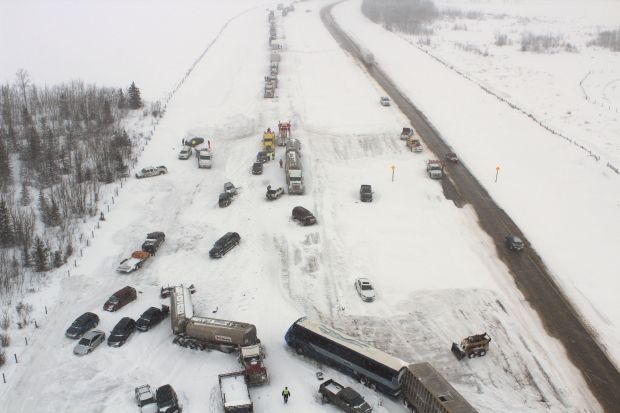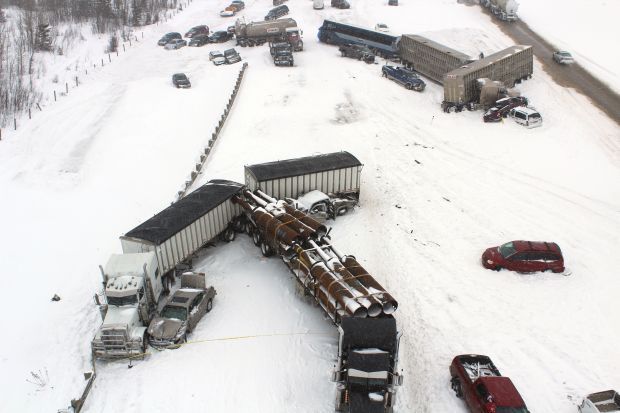EDMONTON – Nearly one week after the huge pileup on the Queen Elizabeth II highway south of Edmonton, RCMP continue to try to figure out exactly what happened.

Hundreds of vehicles were involved in several multi-vehicle collisions along the highway March 21 and 102 people were injured.
The enormity of the crash has made for a very complicated investigation for RCMP.
“We’re trying hard, and we’ll do what we can,” says Constable Chris Noble with Ponoka RCMP. “We just need people to call us and let us know they were there. Call Ponoka or call Leduc directly and let us know.”
Using statements from those involved, along with scene photos and police and traffic reports, RCMP members are trying to piece together the factors of the crash; what happened, when it happened, and who was involved.
“It would be helpful to us to have you speak to us directly.”
Noble is asking anyone who was part of Thursday’s collision to contact the Ponoka or Leduc RCMP detachments directly (403-783-4471 and 780-980-7267 respectively).
“Trying to look at something on paper, and in statements, and keep it all straight, it is difficult,” admits Noble.
So, the Ponoka RCMP is working in teams. Some members are putting together a picture of the injury collisions, other members are working on the rest of the scene. Together, they’re coming up with a better understanding of the crash, and they’re keeping track of the layout of the scene on a huge white board.
“When it becomes a visual thing, you can get the bigger picture,” explains Noble.
“It just gives us a good visual of what the totality of it is and … makes it much easier to work with. Then, when you start getting your collision reports, and your Alberta traffic collision reports done, then you can start – piece by piece by piece – a big jig saw puzzle.”
Every fragment of information is useful. RCMP officers are using photos from the scene and witness accounts to recreate every element of the crash.
“I actually searched the internet and found pictures that were taken prior to us arriving. So, the multimedia aspect of life today became a little bit helpful, because I found a picture that showed me some vehicles before they were even moved.”
“The people who got the really good pictures were the people who were out at the collision who were involved, and they started snapping pictures because they wanted to be able to tell their insurance companies, they wanted to tell their bosses, ‘look what happened to me.’”
Noble says this investigation is a huge one, but one that is slowly making progress, thanks to cooperation of colleagues.
“Everybody’s putting their little piece into the whole thing, and it all comes together quite nicely. It’s getting there.”
That spirit of cooperation is something Noble witnessed firsthand when he initially responded to the crash.
“When I got there and I came over the crest of the hill and looked down on it, I was in awe. I haven’t seen a mass collision like that in the service I’ve had. I’ve heard about them, but to see it… and then, where do you begin?”
Noble – who’s been a police officer for 23 years – says all the law enforcement and emergency officials worked together to help injured people and then secure the area.
“Leduc and Millet and Wetaskiwin and all the emergency crews are there, and ambulance, they had things well in hand and well underway, they had buses on scene already to transfer people out and they did a great job. Give them credit for the way they were able to pull all their resources together and work together.”
Other officers from surrounding areas even offered their assistance, says Noble.
“I did receive a phone call from an EPS officer, an inspector, asking if we needed any help, and at that point… our guys had been out on the road blocking traffic for quite a few hours… so I asked if they could provide some resources to relieve our guys and there was no hesitation whatsoever. They said, ‘we’re there, what else do you need?’”
“It’s nice that we can work together as one big team.”
That team approach will also be needed as officers continue with the investigation. How do they track down every applicable detail?
“One phone call at a time. Take a license plate, contact the registered owner, ‘were you there? Yes I was. Who was in your car?’ Write it down, make another phone call.”
However, Noble admits simply finding a license plate wasn’t always easy in this situation.
At the scene, officers found a car that didn’t have a license plate on it. In fact, a layer of the back bumper was torn off by another vehicle.
“I find a bumper skin, pick it up,” recalls Noble. “Looks like the same colour, does it match? Yes, it matches, check the plate, it belongs to Sebring. We just start putting things back together and then start calling people.”
Noble says other detachments, like Sherwood Park, Peace River, even Edmonton Police, are being contacted by people involved in the crash. Instead of having those officers pass on the information to Ponoka RCMP, Noble says his detachment can deal with things more efficiently if people call them directly with their license, registration, and insurance information, as well as a written statement that they can email or fax to RCMP.
“You provide a statement; it’s the law to provide one.”










Comments